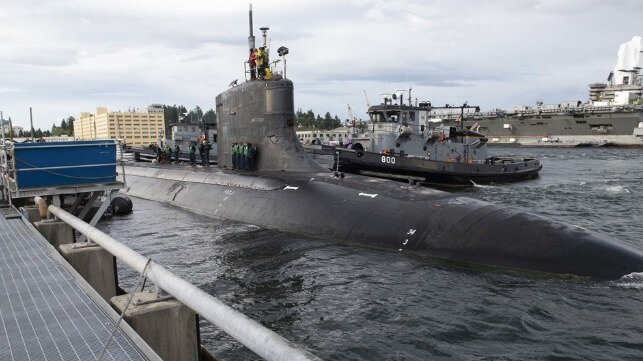Failure to Follow Safety Standards Led to Seawolf-Class Sub Grounding

The U.S. Navy has released the results of a command investigation into a damaging underwater collision involving the Seawolf-class sub USS Connecticut last year, and the results suggest a breakdown in navigational safety standards on board the ship.
On October 2, 2021, USS Connecticut ran aground on uncharted terrain while running submerged in a "poorly surveyed area in international waters" in the South China Sea. 11 crewmembers sustained injuries, and the sub limped back to Guam for emergency repairs. After patching up, she transited back across the Pacific to San Diego, then north up the West Coast to return to Bremerton Naval Shipyard. Photos of her return to San Diego suggest that she sustained extensive damage to her bow, and she will be out of service for an "extensive period of time" while repairs are under way.
BREAKING: USS Connecticut (SSN 22) Seawolf-class nuclear attack submarine coming into San Diego - note obvious damage to bow - December 12, 2021 #ussconnecticut #ssn22 pic.twitter.com/vNT7sTPzod
— WarshipCam (@WarshipCam) December 12, 2021
The heavily-redacted report suggests that the grounding was avoidable and that the crew did not follow procedure. There may have been warnings. In the year leading up to the casualty, the sub's commander had been cited twice and investigated once for allegedly poor performance, to include “inadequate supervisory oversight, ineffective accountability practices, and superficial self-assessment," as well as "lack of improvement and reluctance to accept feedback."
On April 14, 2021 - six months before the grounding - the Connecticut struck a pier at Naval Base Point Loma, prompting an investigation. The investigating officer concluded that the allision could have been prevented, and he recommended that the CO and most of the command team should "receive administrative or disciplinary action for dereliction of duty." The commander of the sub's unit, CSDS-5, decided that this was not warranted. Instead, the CO, XO, navigator, officer of the deck and assistant navigator were formally counseled about the deficiencies discovered in the investigation.
USS Connecticut deployed to the Pacific in May. On October 1, she had to conduct a "humane evacuation," a nonemergency personnel change for personal reasons. Her assistant navigator laid out a "temporary route" to Okinawa. During planning, the CO asked for a higher transit speed, above 16 knots. The trackline selected passed through uncharted areas with poor survey data, but in a post-casualty interview, the assistant navigator said that he believed the soundings were "excellent" throughout the route.
At 0115 hours (Zulu) on October 2, as the sub was under way for Okinawa, the quartermaster of the watch logged a loss of soundings in the fathometer log. However, he did not take the required actions for a loss of soundings, the investigation determined. This pattern was repeated at 0145 and 0200.
At 0424, the assistant navigator instructed the quartermaster to remove a designated "stay out" area from the sub's Voyage Management System, its advanced electronic chart system.
At about 0518, soundings on the fathometer began to deviate from charted depths. The watch team discovered the discrepancy and noted "rapid shoaling," but the officer of the deck (OOD) did not report the phenomenon to the CO. He later told investigators that he was concerned with the shallower-than-expected soundings but that he "did not assess a need to take aggressive action." He did not consider reducing speed, and instead gave orders for a one-degree-up angle to ascend.
At 0618 hours, Connecticut's sonar officer identified signals indicating "biologics" ahead. Within one minute, the sub grounded on an unspecified underwater hazard in international waters. The sub surfaced and obtained a GPS fix, which put it about 1200 yards from the position indicated by its inertial-navigation system.
Injuries from the accident included one concussion, one fractured scapula and nine minor injuries. The extent of the damage to the sub was not disclosed, except that the bow dome "detached during the transit" back to Guam and that divers later found rocks in two main ballast tanks.
The investigation found multiple failures leading up to the casualty. The navigation team failed to identify and properly mark at least 10 charted hazards to navigation near the site of the grounding, including two areas that were shallower than the maximum allowed operating depth on the route. They deviated from navigation planning protocol by using a verbally-approved "temporary route," bypassing a longer review. They did not recognize that they would be passing through restricted waters, which should have triggered an augmented watch team with more navigation watchstanders on duty. During the casualty transit, the OOD and quartermaster did not take action when they lost fathometer soundings early in the watch. The quartermaster did not make recommendations to ensure safety of the vessel, such as reducing speed and depth.

that matters most
Get the latest maritime news delivered to your inbox daily.
"No single action or inaction caused this mishap, but it was preventable. It resulted from an accumulation of errors and omissions in navigation planning, watchteam execution, and risk management. Prudent decision-making and adherence to standards in any one of these three areas could have prevented the grounding," concluded the investigators. "Connecticut peaked to perform at standards during inspections and evaluations [but] in the absence of external oversight or evaluation, the CO, XO, COB, and other leaders failed to maintain day-to-day standards."
The investigating officer recommended nonjudicial punishment for dereliction of duty for the sub's CO, XO, navigation officer, assistant navigator, and the officer of the deck and quartermaster of the watch. He also recommended a review of the Navy submarine community's HR processes to identify lessons learned. "Although the Connecticut CO, XO,
and department heads were fully qualified for their assignments, this was a particularly weak team," he concluded.
